|



FastCounter
by LinkExchange
| |
PhilZone
Diary of CHRR 14
Phil R. Elliott
After a couple years of being unable to attend the California Hot Rod Reunion, 2005 seemed a must do.
So, several months back, my pal Buzz Baylis booked us a room. Usually, I like to stay at the Vagabond in the north end of Bakersfield, next to the infamous Milt’s restaurant, where so many historic racers have broken bread over the years. The Vagabond is also the haven for many other members of Standard 1320. That way, whether at the track or away, one can count on a constant barrage of bench racing among friends. As luck would have it, Vagabond Inn was full.
It was the first strike. Still, I searched online and Buzz booked us into the Best Western just across 99 from the Doubletree – the host hotel and scene of much of the off-track craziness. Plus, this motel is just a block from Zingo’s, another famous greasy spoon and racer hangout. And, another of my dear friends, brilliant model builder Vern Scholz from Calgary, said he was staying there. OK, so this could work out.
As a back up, we found another room at a Motel 6, which I verbally turned over to my great friend, Fred Vosk.
As months worked down to weeks, my anticipation built, mostly because of the attending cars. I began to get very excited about seeing the restorations of Jerry Ruth’s last FED, the ex-Jim Crooke Assassin and the wicked Eagle. All three were northwest standouts, Ruth’s for its historic victories, the Assassin and Eagle known mostly for their looks. The other car I wanted desperately to see was the engineering masterpiece known as the Dragmaster Two Thing. On-line photos only served to get me further whacked out of shape!
Of course there were people I wanted to see. They are always the main focus of CHRR for me. Second are the assembled cars and a distant third is the race that just happens to be going on during the festivities. One person I wanted to be sure to see was Dave Wallace Sr., one of seven being inducted into the Hall of Fame. Besides, I looked forward to spending quality time with Buzz, Fred and Vern.
So, my plans and desires were in place.
Then, another ingredient fell into place. I was able to purchase a new car. For several years, the 89 Mustang I owned, not coincidentally nicknamed POS CAR, sorta kept me trapped close to home. It wasn’t a “bad” car, just reliably unreliable. I purchased a 2005 Honda Element, which was at my disposal, so I had one less excuse.
Just a couple weeks in front of CHRR, Buzz informed me that his wife had planned a surprise weekend getaway for him and he would be unable to attend. Strike two. The surprise had been revealed when Pam invited our mutual friend, Mendy Fry, to attend the dinner in San Diego and was told, “Uh, I’d love to except I’m racing that weekend,” and, “Are you sure Buzz won’t be at the race too?” He admitted to me that it was his own fault – he had failed to write CHRR on the family planning calendar. And, since family is far more important than racing, especially as we all get older, Buzz was going to San Diego.
After describing the situation to Fred Vosk, I told him to just get to Bakersfield, he could stay with me at the Best Western and we could ride around in style. He had several options but as the days went by each of them fell by the wayside. He wouldn’t make it. How many strikes could I handle?
Two weeks before CHRR, I flew to Seattle to a pre-90th birthday celebration for my mom. It was up Friday and back Sunday. As fate would have it, two seats from me on my return was a young woman that coughed the entire flight. By Wednesday, I too was coughing, my temp rose to 102.6 degrees and I had all the symptoms of not attending a race. The following weekend I spent in bed, and as the next week progressed, I made up every reason not to go to Bakersfield. I mean, several of the people I looked forward to seeing would not be there, and I just didn’t want to go by myself. Plus, my workload had increased and walking away from it would be tough. There were a dozen other excuses that seemed positively reasonable too.
As I methodically packed Wednesday evening, reasons, excuses and rationalizations for not going continued to build. I also paid all my bills that night and realized just how little money I had to last through October – yet another major reason not to head for a “play day.” When I awoke Thursday, I knew I had serious trepidations about CHRR but nonetheless loaded everything in the Element. My ETD was 11am.
After a couple hours at work, I went back home to get several things I’d forgotten, dropped the paid bills at the post office, and headed for the open highway.
My chosen route was beautiful 88 west to 99 south with a hope to reach Bakersfield for a Standard 1320 dinner. I left Carson City ninety minutes behind. Then, I encountered more delays. As you certainly know, trying to make up time on a twisty, two-lane mountain road is not often possible. Add in two paving crews – both stopping traffic and using pilot cars – and three accidents – two involving vehicles over the side, and it was almost amazing that I merged onto 99 by about 5pm. Of course, by then I had to absorb heavy stop-and-go traffic in each city I encountered.
I pulled into my motel parking lot at around 8:15pm and stepped smartly up to the desk. Buzz had originally made the reservation for Friday and Saturday nights. Later, he had changed it – he thought – to include Thursday. Whether the problem was one of communication between the national reservations desk and the local motel, that Buzz used date numbers instead of weekday names, or just what, there was NO room for me. Great. And, CHRR for the third year had sold out the town. I began a slow inner boil, negatively reminding myself of the many reasons I’d had for making this seven-hour drive. Frantic work by a night manager, with radio communication to two unseen voices, found a single; adequate since neither Buzz or Fred would be joining me.
I then rushed over to the Doubletree to see who might still be there. Surprisingly, roughly half of the attendees to what has become known as “Ma Green’s Party” were still there and I was able to mingle and eat a bit.
I’m not sure how to put it gracefully but after unpacking the car, hauling about seven loads to the second floor and retiring, I trotted all night. Continuation of my illness, food poisoning from a quick burrito or just a day of upsets, who knows? Nonetheless, when Friday dawned, I felt even less like heading for a hot dragstrip.
And hot it was – 90-plus degrees of it. But, as I was filling out the required paperwork to receive event credentials, I heard a loud, “Hey Phil!” It was Jerry Ruth, driving through the gate nearby.
I walked through Gate 1 moments later and went over to offer tribute to my king. Jerry then gave me a quick view of his all-conquering 1970/71 mount. I was also re-introduced to the Eagle Electric, one of my all-time favorite full tail cars, a Tom Hanna creation that he never liked. Both are presently owned by Bucky Austin, who also was debuting his 1971 Top Gas ride. I “hello’d” with Bucky, as well as Jerry King, another northwest standout. Over the years, he raced Stock, Jr. Fuel and Pro Stock as well as other things.
The restoration of JR’s last FED is well done and pretty but far from as stunning as it once was in all its magnificent pearls and candies – it certainly looks nice but it’s just not as showy as the original.
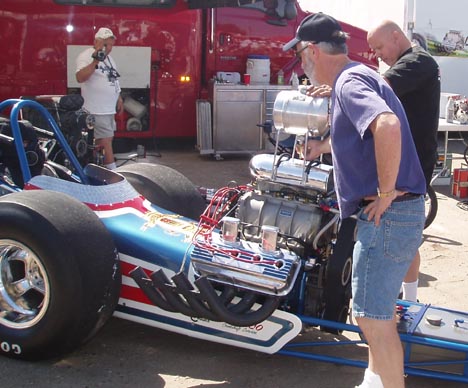 |
| The first car I heard was the restoration of Jerry Ruth’s 70/71 mount, his last FED. That’s the King in the ugly shorts, flanked by actual car owner Bucky Austin in black shirt. |
Jerry Ruth was known for his competitive edge in racing and showing. In comparison, the restoration has similar colors but they are in currently available paint, not the artistically applied, hand-loved lacquers of old.
The Eagle car has always been a sparkling memory. When Frank Rupert made the turn at Puyallup, every angle and flake refracted light to a dazzling degree that gave me shivers! It was more sculptured grandeur than my young eyes could absorb. Also, I remember the color in two different ways. In bright light, it appeared metalflake orange, in lower light, almost root beer brown. The restoration team went with the latter, and like Ruth’s, Eagle is less spectacular than the original. My friend Vern later shook his head and said, "They got it wrong..." We conversed about it and after he got home, at my recommendation, he looked up the color article in a 1966 Hot Rod. The description is as follows: "...candy TANGERINE with black accents, all covered with Strato firemist metalflake."
 |
| The graceful tail feathers of Eagle Auto Electric, also owned now by Bucky Austin. |
The car is still a sight to behold and I am so glad that Bucky Austin has made the decision to restore and maintain such wonderful pieces of history. His investment in historic northwest cars will become legend within a few years. His next project is one of my all-time favorites, "Sweet 16," a twin A/FD with injected Chevys that held its own in many a Top Fuel show thanks to Jerry Verheul and driver Dave Weis.
After my time with the northwest group, I went for a walk.
By yourself, you can cover a lot of ground in a hurry. And I saw a lot of things. I was trying to get the lay of the land, see where various teams were parked, and look for interesting vehicles. I spoke to Ms. Fry who was busy slurping watermelon, as well as Phil Lukens and Tom Willford.
Knowing the situation of her team’s shallow pockets, I asked Mendy Fry what she thought her chances were. She responded candidly that they had “five pistons and eight liners.” Her later qualifying attempts would be less than necessary to get into the Top Fuel show, a best of 6.13 missed the all-time quickest NTF bump (6.11). Her Plaza Hotel teammate Sean Bellemeur qualified first (5.868/253).
Since he quit Competition Eliminator Phil Lukens has been happily running the same Chrysler-powered Fiat altered at the nostalgia events – with no external pressures. His Blair's Speed Shop Topolino may have a slightly larger engine than it once did, but it looks and acts pretty much the same, and I suspect costs Lukens a lot less in dollars and frustration.
Tom Willford buys and sells race collectables and aging race parts, and has a vast knowledge of just what cars are being restored by whom. He’s always a great chat. He introduced me to two young Willys “freaks” that joined the conversation. Dave Secrist is restoring arguably the most famous gasser in the northwest, the GM Auto Sales B/G 41 Willys coupe, while Dale Little has reassembled – from a basket – a totally original 33 Willys coupe. Both guys were genuine in their love for the old days – it was refreshing to see and hear.
I tried to take in as much as I could. When I decided it was time to head back toward “the Grove”, where most of the feature cars share space with trees that have been devoted to fallen heroes, I chatted with Dave Wallace and Al Kirshenbaum at the Hot Rod Nostalgia booth. I passed so many Racecars, rods, hot rods and rat rods I began to get calloused. In the Grove, there were familiar shapes and faces, and then I stopped dead in my tracks. It was one of the cars I have always dreamed of seeing – The Dragmaster Two Thing.
Back in dragracing’s formative fifties, all manner of wheeled experiment tried out the new-fangled acceleration disease. When the infamous NHRA nitro ban came along, many builders tried multi-engines to make up for the lack of canned horsepower. Dragmaster, among the first to mass-produce drag chassis, was quite successful during this five-year span. Jim Nelson and Dode Martin built a simplistic, lightweight, nicely trussed slingshot that lent itself to all the classes available at the time. Many of their “house” cars were heavily covered in the magazines which in turn attracted factory-supplied engines in the early 60s.
In a time when nicknames were hung on racecars, Dragmaster did likewise. Science fiction movies were huge at the time, so when Jim and Dode built a twin, they called it “Two Thing.”
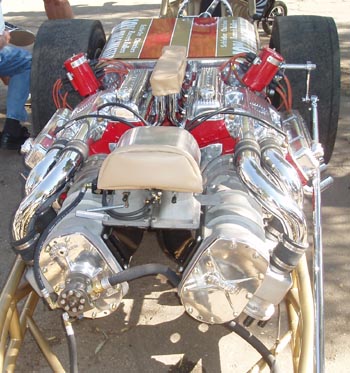 |
| One of my attractions this year was the amazing reproduction of the Dragmaster “Two Thing.” |
It was Best Engineered everywhere it appeared, including the 1960 NHRA Nationals in Detroit, where it also set Top Speed (171.10). Few remember that Two Thing was also in the Top Eliminator run-offs that year but lost in a semi-final to eventual winner Leonard Harris in the Albertson Olds.
When AMT decided to build a highly detailed dragrace model, they plasticized Two Thing. The chassis was changed from a Dragmaster-style cage to one more like a Fuller, I have never known why. Nonetheless, AMT got the Potvin-drive blown Chevy powerplants just right. The kit also came with a separate chassis and bubble-canopied body that roughly replicated Romeo Palamides’ 1958 mount, as well as a blown Chrysler AA/A Fiat that did very well to duplicate Walt’s Puffer. With a little parts box borrowing, the model kit would almost build three cars – it was amazing in its day and is still one of my all-time favorites.
I stood and stared at the repop of this famous beast. Its engineering is just as sound today as it was 45-years ago. I ogled longingly the 1:1 versions of the very pieces I had overglued so long ago. Two Thing is flat an amazing creation.
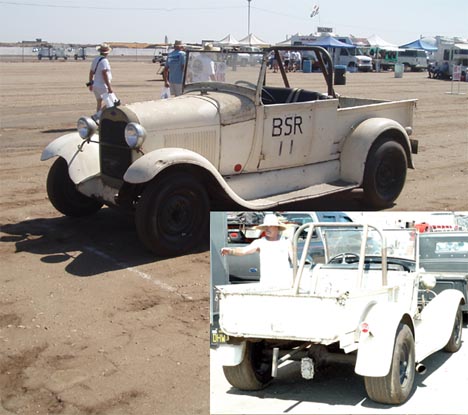 |
| Wandering, I found this Model A street roadster, which, other than the rear tires and later model rollover structure, looks for all the world as if it lived in 1961. |
I then spent some time with Standard 1320, saying hellos and checking on members’ cars – many the cacklers that spectators have come to enjoy over the years. It was arguably Standard 1320 member Bill Pitts and his lovingly restored Magicar that got the whole start-it-in-the-pits deal going that led to what is now known as “Cacklefest.”
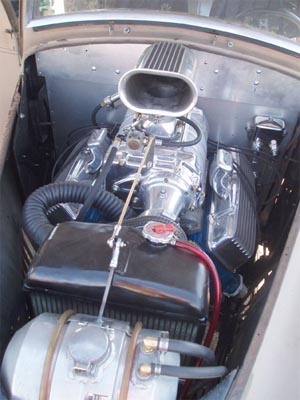 |
| I happened on this little scene. Under the awning were two English Fords. The ex-Becker & O’Connell Hummer was found and resurrected by Steve Dennish of Lime Works Speedshop. The little car was rather stout in the 60s with a GM six-cylinder. So along came friend Kerry Burch, a Brit like Steve, they found a virgin Prefect, built the underside a carbon copy of Hummer, and installed an absolutely period correct blown Caddy and LaSalle 3-speed trans. I swear I couldn’t get enough! |
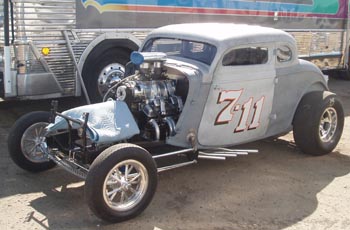 |
| One cannot step ten feet without experiencing Nirvana – such as this tasty fuel coupe. |
 |
| Two of Jim Lytle’s creations rested amongst the unending rods, both Allison powered of course. “Big Al” and the White COE truck were regulars in early magazines. |
After that, I was hot, tired and hungry, so headed for the motel. I showered and changed, then called Vern to see if he’d arrived. A few moments later, Vern, his son Chris and I walked over to the Doubletree for the evening festivities. Already, the parking lot was full of rods and people. We split there, and I headed for the CHRR Honorees press junket. It was an informal affair where old friends could just say, “hello,” have a snack and a soda, and move along. I wished Dave Wallace Sr. and his entourage well, and leaned on a wall, taking in the people and surroundings. Several folk shook my hand and I re-met many of my peers, such as ex-Hot Rod editor Jim McCraw, crazy freelancer Al Kirshenbaum, Mark and Dawn Hovsepian, Geoff Stunkard, as well as racers and heroes from the past.
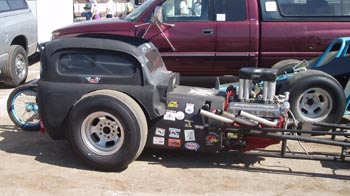 |
| I took a real shine to this Comp coupe, with a body taken from a cut-down 48 Ford pickup cab? Once, dragracing was filled with such treasures, unlike the cookie cutters of today. |
All too soon, it was time to head for the real induction ceremony, hosted by Dave McClelland. In his opening remarks, Dave read a congratulatory letter from the California governor, Arnold Schwarzenegger, which announced that Kern County had made the weekend “Official CHRR Days.” Big Mac stated that there were over 130 members of the press (including England and New York Times), and that there would be more cackling fuelers the following evening than ever before.
The first recipient was the Golden Age Award. CHRR and the NHRA Museum recognize there are many personalities that did a great deal for dragracing but are in danger of being forgotten. This year, it was Charles “Scotty” Scott, known for his string of Scotty’s Muffler drag and lakes machines. His son, 60s teenage driving standout Billy “the Kid” Scott, accepted for his father, who had passed away only a few days after hearing he had been chosen for the award.
Next up was the first of those being inducted into the Hall of Fame, AA/FA standout Leon Fitzgerald, who built his reputation in a Chevy-powered Bantam named in response to his major competition. Since one of the best AA/FAs out there was Pure Hell, his would be called Pure Heaven. He spoke of the memories starting with bolting an Olds engine in a 56 Ford pickup, but paid the largest tribute to his wife Darlene, just four months shy of their 50th anniversary.
Next up was the surprise of the evening (for me). Ed Justice Jr., a great race photographer in the 60s and 70s and part of the Justice Bros. Car Care Products family, honored ALL of the AA/FAs and their pilots with the CHRR Spotlight. Many of the wildmen were present and stood when a roll call was read. I still find it an irony that this breed – arguably history’s most popular style of racecar – was allowed to die only now to be heralded. I was awed to know how many of those men were in one room.
Next up came one of my early heroes, Dick Landy, so instrumental in the early A/FXers that evolved into funny cars, and five years later, one of the major innovators in Pro Stock. The “Dandy One” who once could have passed as a linebacker, spoke just a short time, now shriveled with age and disease. He was humble about the beginnings, and said he never could believe “how lucrative things would be when I was asked to run the stocker.”
Next up was one of Landy’s FX peers, a driver called a “Fox” in more than one headline, Shirley Shahan. When I first read about her was in early 65, wheeling a factory-backed S/SA hemi Plymouth, the first in her line of Drag-On Lady rides. She and husband H.L. Shahan, who was also teen sensation Butch Leal’s crewchief, toured with the altered wheelbase cars most of the summer, but chose to leave her car mostly stock. It was a good move because at the NHRA Winternationals in 1966, she became the first woman to win a national event. What I hadn’t known before she spoke was that she’d won Top Stock at the first March Meet back in 59, a feat that earned her “… two cases of beer, two Tee Shirts and a wall plaque.” Her best memories are of the travel and meeting so many people who have remained friends. She closed with, “I love dragracing,” to thunderous applause.
Safety guru Bill Simpson was next, and after the combination introduction and testimony from emcee McClelland, he received a standing ovation as he mounted the stage. Bill could have gone into great detail about how he perfected drag chutes and firesuits, or how his contributions have save untold lives. Instead, he paid tribute to the dragracers that had helped him make a start, which he did in his single-car garage. When it became obvious he had run out of room, several racers pressed him to get into larger quarters, and he managed to buy a piece of property in Harbor City. A work party of racers helped erect a 2,000 square foot building, and racers did ninety percent of the labor and specialized items such as wiring and plumbing. “When we finished,” Simpson said quietly, “We wrote in the concrete floor, ‘Built by Drag Racers.’” Though he moved on to the Indy 500 and NASCAR, he has not lost sight of his heritage.
The shortest speech was from Dave Uyehara. Following McClelland’s introduction that suggested Davey has tested many of his own construction techniques, the chassis builder told a simple story of a guy (Tom Prufer) that hauled a never-assembled K-88 chassis into his shop 25-years ago wanting him to finish it “…for something called ‘nostalgia racing.’” He could not imagine what those little seeds have become.
Dave Wallace Sr. was next. I had wondered after all the years how many people would remember his accomplishments. After all, he wasn’t a racer or an engine builder. In the early 60s, Wallace was a family man, making ends meet as a postal employee. As a sideline, he did virtually everything at San Fernando Raceway, and he drug his family along to do odd jobs as well. One thing he took on was the public relations of the track, which unlike most southern California strips ran its races on Sunday. Coverage for those events was in Drag News, a publication that printed every Wednesday. Publisher Doris Herbert made the final decisions on all insertions Mondays, had the type set and photos half-toned, and laid out the newspaper Tuesdays. Most track reporters and photographers posted their stories/photos on Monday, and even Special Delivery failed to reach the Drag News office before Tuesday, too late. Wallace figured out a plan. He used a new-fangled Polaroid camera to shoot mostly winners circles (his other track duties precluded him standing on the starting line taking pictures), banged out a story on his old Underwood manual, and headed for the Panorama City PO where he worked. If he could get his little package there before midnight Sunday, he could access the direct-to-LA mail pouch. San Fernando stories and photos were on Doris Herbert’s desk on Monday morning, and almost always made the same week results. Wallace’s efforts nearly always “scooped” other tracks, and caused quite a fervor among track reporters throughout SoCal. With the floor, Dave Wallace Sr. spoke for quite awhile. He has many wonderful memories of dragracers he thought of as his extended family, and mentioned many by name. It was inspirational. I know his sons Dave and Sky quite well, and have for many years. I know how much they both thank their father for dragging them to a dragstrip every Sunday, and see it in their smiles and eyes nearly five decades later. Mr. Wallace closed with something that made me tear up: “I am honored, humbled and proud.”
The first recipient of the Wally Parks NHRA Motorsports Museum Board of Directors Award was Jack Williams, who drove the Crossley, Williams & Swan AA/FD to many titles in 1964, including the Winternationals, the Hot Rod Magazine Championships and the March Meet. He was runner-up at Indy to Don Garlits, and accrued enough points in the first year nitro returned to NHRA to be the first Top Fuel World Champ. His driving career only lasted into 66 when he was badly burned following a winning final at Irwindale. As a card carrying Smokers car club member, his duties at Famosa Raceway had always involved promotion and sales. Williams moved on to racetrack management and later ownership as well, including New York National, Bakersfield, Fremont, Sears Point and others. After his introduction, which included the probability that he has forgotten more about drag racing and race promotion than most will ever learn, Jack told the roughly 1200 assembled that he was deeply honored, he shared a few simple anecdotes, then closed with “It is much better to be a has been than a never was.”
Last on the docket was honoree and CHRR Grand Marshall Dale Armstrong, who was forced to wait as Dave McClelland read his accomplishments. From humble beginnings on an Alberta farm to out-thinking everyone to the first 300mph clocking, the list was long. But when the man who is certainly one of the most savvy and deepest thinkers to ever set foot on a dragstrip reached the podium, he was among the meekest, softest spoken of the evening. He recounted heading for southern California with a farm-built FX Chevy II, and how he felt the FX stars there were like gods. “If Dick Landy would have walked up and looked at my car,” Dale said, “I would have fainted.”
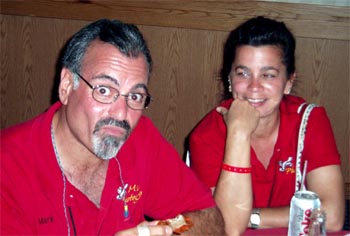 |
| Photographers par excellence and seeming soul mates, Mark Hovsepian and Dawn Mazi-Hovsepian enjoyed the all-too-brief respite during the pre-Honoree press break. They show they’ve already spent a long day in the sun. |
When the honoree program ended, I headed for the room always filled with photographers, writers and modelers. It is always packed as everyone wants to see just what things are available, and what folk have built over the past year or so.
Right by the door was Roger “Riceman” Lee and his 1:25 scale dragsters. Roger has been building since he was very young and his knack for scaling realism is nearly unbelievable. Many modelers are detail freaks and I admire them as masters. Most, however, make their models look as if they have just rolled out of the paint and chrome shop. Roger chooses to build his as if they have a half-season of racing and trailering on them – a technique called “weathering.” In my humble opinion, they are far more realistic. And, he has become a master with brass rod, block and sheet, crafting 100% in this venue. His recent commission (from Ron Johnson) of the Shubert & Herbert sbChevy AA/FD is of brass, and it is truly a masterpiece, worthy of placement in any gallery. I also saw in person for the first time his rendition of the “Loukas coupe” and cannot fully comprehend how a person of Lee’s talent can achieve such finite detail. He handed me a dragster he’d built for the StraightLineModeler Diorama I’m helping organize (if you want to check out that project, go to http://www.straightlinemodeler.org/dio/dio.tml>).
I moved on to Bob McClurg’s table. Bob was a standout photographer in the 60s and 70s and filled magazines and newspapers with his work. He’s the guy that shot the definitive photo of Willy Borsch, sideways at Pomona, aimed at Bob but with the wheels still headed downtrack. It has been a great selling poster over the years. Bob personalized and handed me his book, “Diggers, Funnies, Gassers & Altereds”, which I will read and review very soon. Just leafing through it gives me goosebumps!
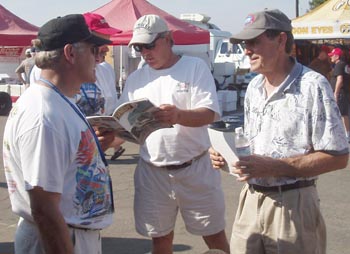 |
| Fellow Calgarians, CHRR Grand Marshall Dale Armstrong and superb model builder and racer Vern Scholz, had a few yucks in the pits Saturday morning. |
I then sat with artist and photographer Tom West, owner of Milestone Development. He had several of his latest diecast collectables and projects on display. In comparison to other available diecasts, his are extremely accurate. Where other manufacturers use a single chassis/engine/wheels/tires combination and fit it under a variety of bodies and paint schemes to replicate a dozen different cars, Tom individualizes everything, right down to the carbon-fiber injector hats. And, unlike others that have plastic frames with metal bodies, Milestone funny cars have real fiberglass bodies! Tom presented me with one of his 1:16 scale collectables, the Kenny Bernstein Buick LaSabre more commonly known during that FC era as “the Batmobile,” a car that thankfully helped NHRA come up with tighter FC body rules (something that certainly needs to be addressed again, IMO).
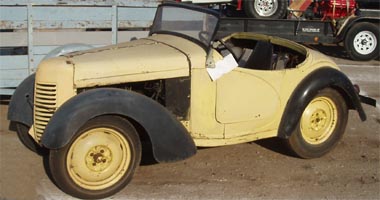 |
| Didja ever wonder what a real Bantam looked like, you know, like Pure Hell and Pure Heaven. Well, here ya go, a stocker in the swap area, going for around $6Gs. |
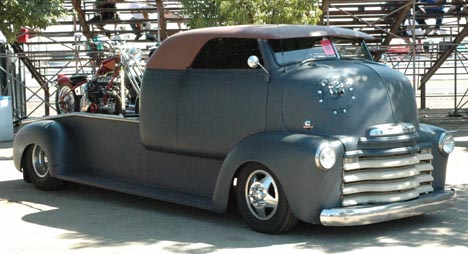 |
| All I have to say about this COE with Carson-style top is, “Badassss.” My Nova FC would look great on this truck. |
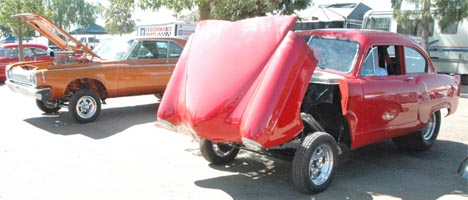 |
| The huge car show included side-by-side gems like a tubbed Henry J and a straight axle 64 Dodge. |
When I decided that I was about done for the evening, I left the Doubletree interior and tried to get through the crowd outside with my full armload of goodies. There were many happy greetings that slowed my progress and I kept a sharp lookout for Vern and Chris, hoping for a little help carrying stuff. But no luck, so soon, I began walking.
Earlier, this few-block walk seemed easy but at that hour it was a hardship and I whined to myself, “Whose idea was it to walk?” Of course, there was no problem and I made it easily.
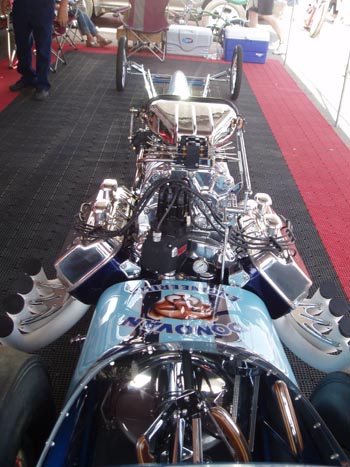 |
| Creitz & Donovan was just one of the beauties recently completed. Amazingly detailed. |
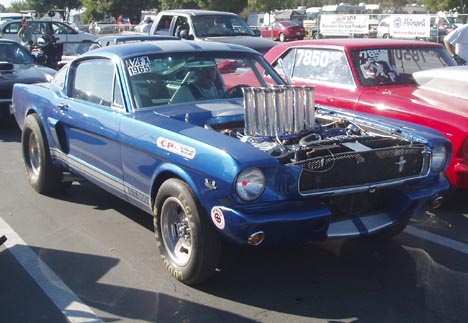 |
| I saw this Mustang in the pits and in staging, but never saw it run. I love tall injector stacks… |
But my day was hardly over. I’d invited Byron Stack, owner of the Gasser Madness website to thumb through a bunch of photos I’d brought along. He was camping at the track but he’d come to town to take part in the activities. He brought Peter and Yvonne Broadribb, owners and restorers of the Gene Moody Garage 55 Chevy gasser that won the Street Eliminator World championship in 1965, from their homebuilt motorhome at the track. I waited about an hour before hopping into my PJs and bed. I was reading a bit with one eye on some movie when the knock came. Everyone came on in and we chatted about CHRR, gassers, dragracing, and a whole lot more. Finally, they’d had enough and I turned out my lights and had a far better night than the one previous.
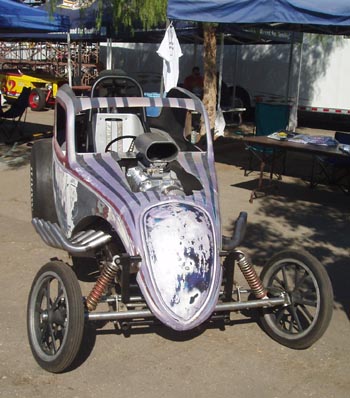 |
| The last time I spoke to Pete Eastwood, he bought Marv Eldridge’s Challenger FC. He showed up at CHRR with the Mondello & Matsubura AA/FA which he fully intends to have fully operational by next year. |
Phil R. Elliott
Have a comment on this story? Click HERE!
|
| |
|

